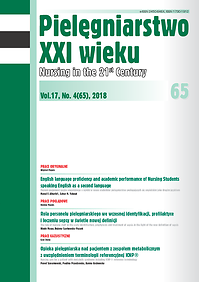The role of nursing stuff in the early identification, prophylaxis and treatment of sepsis in the light of the new definition of sepsis
DOI:
https://doi.org/10.2478/pielxxiw-2018-0034Keywords:
sepsis, nurses, prophylaxis, SOFA, qSOFAAbstract
THE ROLE OF NURSING STUFF IN THE EARLY IDENTIFICATION, PROPHYLAXIS AND TREATMENT OF SEPSIS IN THE LIGHT OF THE NEW DEFINITION OF SEPSIS
Introduction. It is estimated that every year 31 million people suffer from sepsis and even 6 million cases of illness end up in the patient’s death. In 2016 the current definition of sepsis was established as a life-threatening multiorgan failure resulting from an abnormal immune response caused by patient infection. The pathobiological approach rejects the current method of diagnosing sepsis based on the occurrence of SIRS, because many other non-infectious diseases may also cause its occurrence. There was proposed a scale of progressive organ failure called SOFA and qSOFA. In May 2017, WHO released a resolution that obliges European Union countries to raise awareness about sepsis prevention, diagnosis, treatment and management.
Results. A nurse is the person who spends the most time with a patient, thus becoming the best observer of changes in his/her vital functions and well-being. Nurses working in basic health care, hospital emergency ward and all departments not involved in intensive medical care, have an important role in prevention of infections, as over 70% of sepsis cases begins in a non-hospital environment, and the current level of public knowledge reaches only 14%.
References
1. Mayr FB, Yende S, Angus DC. Epidemiology of severe sepsis. Virulence. 2014; 5: 4-11.
2. Kleinpell RM, Schorr CA, Balk RA. The new sepsis definitions: implications for critical care practicioners. American Journal of Critical Care. 2016; 25(5): 457-464.
3. Fujishima S . Organ dyfunction as a new standard for defining sepsis. Inflammation and Regeneration. 2016;36:24.
4. Makic MBF, Bridges E. Managing sepsis and septic shock: current guidelines and definitions. The American Journal of Nursing. 2018;118(2): 34-39.
5. Reinhart L, Daniels R, Kissoon N. Recognizing sepsis as a global health priority - a WHO Resolution. The New England Journal of Medicine. 2017; 377:414-417.
6. McLean AS, Tang B, Huang SJ. Investigating sepsis with biomarkers. BMJ. 2015: 23-36.
7. Iwashyna TJ, Odden A, Rohde J, et al. Identyfing patients with sevire sepis using administrative claims: patients-level validation of the Angus implementation of the international consensus conference definitione of severe sepsis. Medical Care. 2014;52(6):39-43.
8. Zhang Z, Smischney NJ, Zhang H, et al. AME evidence 001 – the society for translational medicine: clinical practice guidelines for diagnosis and early identification of sepsis in the hospital. Journal of Thoracic Disease. 2016;8(9):2654-2665.
9. Seymour CW, Liu VX, Iwashyna TJ, et al. Assessment of clinical criteria fo sepsis: for the third international consensus definitions for sepsis and septic shock (sepsis-3). JAMA. 2016;315(8):762-774.
10. Larkin J, Holubar M. Severe sepsis. Conn’s Current Therapy. Philadelphia : Elsevier; 2017, s. 601-605.
11. Pruinelli L, Westra BL, Ydav P, et al. Within the 3-hour surviving sepsis campaign guideline on mortality for patients with severe sepsis and septic shock. Critical Care Medicine. 2018;46(4): 500-505.
12. Dei AS, Whiles BB, Brown AR, et al. Three-hour bundle compliance and outcomes in patients with undiagnosed severe sepsis. Chest Journal. 2018;153(1):39-45.
13. Lin CY, Tseng JC, Huang CY, et al. Mortality of severe septic patients between physican’s high and low care volumes. Biomedical Journal. 2017;40(4):226-231.
14. Alsolamy S, Al-Sabhan A, Allasim N, et al. Management and outcomes of patients presenting with sepsis and septic shock to the emergency department during nursing handover: a retrospective cohort study. BMC Emergency Medicine. 2018;18(1):3.
15. Ustawa o zawodach pielęgniarki i położnej z dnia 15 lipca 2011r., (Dz. U. Rozdział 6, art 61.1.)
16. Pączek L, Czarkowska-Pączek B. Sepsa po przeszczepie narządu unaczynionego. [aut. książki] Pączek L, Mucha K, Foroncewicz B. Transplantologia praktyczna. Warszawa: Wydawnictwo Naukowe PWN; 2013, s. 15-25.
17. Kleinpell R, Aitken L, Schorr CA. Implications of the new international sepsis guidelines for nursing care. American Journal of Critical Care. 2013;22(3):212-222.
18. McIntyre PB, O’Brien KL, Greenwood B, Van de Beek D. Effect of vaccines on bacterial meningitis worldwide. Lancet. 2012;380(9854):1703-1711.
19. Torsovik M, Gustad LT, Mehl A, et al. Early identification of sepsis in hospital inpatients by ward nurses increases 30-day survival. Critical Care. 2016;20(1):244.
20. Alderson P, Schierhout G, Roberts I, Bunn F. Collloids versus crystalloids for fluid resuscitaion in critically ill patients. Cochrane Database Sys Rev. PMID. 2000;2:10796729.
21. Schlienger JL, Pradignac A, Vinzio S, et al. Hyperglycemia in the critically: meaning and treatment. Presse medicale. PMID. 2008;12:19056206.
22. Watkins RR, Haller N, Wayde M, Armitage KB. A Multicenter survey of house staff knowledge about sepsis and the „Surviving Sepsis Campaign Guidelines for Management of Severe Sepsis and Septic Shock”. Journal of Intensive Care Medicine. 2017;01:1.
23. Oficjalna strona internetowa kampanii na rzecz przeżycia sepsy: www.survivingsepsis.org. (dostęp 21 02 2018).
24. Kliger J, Singer SJ, Hoffman FH. Using the integrated nurse leadership program to reduce sepsis mortality. Joint Commission journal on quality and patient safety. 2015; 41: 264-272.
25. Jabaley CS, Blum JM, Groff RF, O’Rielly-Shah VN. Global trends in the awarness of sepsis: insights search engine data between 2012 and 2017. 2018;22(1):7.
Published
Issue
Section
License
Copyright (c) 2018 Authors

This work is licensed under a Creative Commons Attribution-NonCommercial-NoDerivatives 3.0 Unported License.




